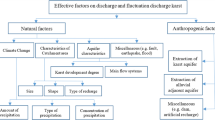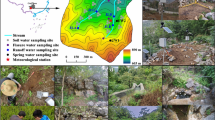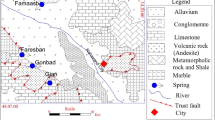Abstract
An epikarst spring in the Maolan forest karst mountain area in SW China was selected for this study. Continuous auto-monitoring of the spring’s discharge, pH, electrical conductivity, temperature and rainfall had been done for more than one year. The results indicated that generally in rainy season, the spring’s pH showed a temporary decrease after rainfall, and the spring’s EC increased temporally, while the spring’s water temperature displayed a transitory increase. However in dry season the behaviors of these parameters were different. According to the spring’s different reflection to rainfall ranging from faintness to intensity, the response could be classified into three grades. The first grade was characterized by no change after rain in discharge, pH, EC and water temperature. The second grade meant slow and little change in a part of these parameters. The third grade showed a distinct change in all of the four parameters. Basing on the spring’s response it was determined that the threshold value of runoff in the epikarst was 12 mm of rainfall. For epikarst, the threshold value was the mark to distinguish effective or invalid rainfall and also an important parameter for the study on the formation of groundwater resources.






Similar content being viewed by others
References
Aquilina L, Ladouche B, Dörfliger N (2005) Recharge processes in karstic systems investigated through the correlation of chemical and isotopic composition of rain and spring-waters. Appl Geochem 20:2189–2206
Aquilina L, Ladouche B, Dörfliger N (2006) Water storage and transfer in the epikarst of karstic systems during high flow periods. J Hydrol 327:472–485
Branka T (2006) How can the epikarst zone influence the karst aquifer hydraulic behaviour? Environ Geol 51:761–765
Cheng GW, Yu XX, Zhao YT (2004) The hydrological cycle and its mathematical models of forest ecosystem in mountains. Science Publishing House, Beijing
Clemens T, Huckinghaus D, Lield R, Sauter M (1999) Simulation of the development of karst aquifers: role of the epikarst. Int J Earth Sci 88:157–162
David GC, James JB (1999) The use of Alkalinity as a conservative tracer in a study of near-surface hydrologic change in tropical karst. J Hydrol 216:172–182
Klimchouk A (2004) Towards defining, delimiting and classifying epikarst: its origin, processes and variants of geomorphic evolution. Speleogenesis Evol Karst Aquifers 2(1):1–13
Lee ES, Krothe NC (2001) A four-component mixing model for water in a karst terrain in South-central Indiana, USA. Using solute concentration and stable isotopic as tracers. Chem Geol 179:129–143
Li ZJ, Chen XL, Zhen HL, Lian YW (2000) Ecology. Science Publishing House, Beijing
Marco T, Diego G, Danilo R, Marco S (2005) Investigating epikarst using low-frequency GPR: example from the Gran Sasso range (Central Italy). Bull Eng Geol Env 65:435–443
Perrin J, Jeannin PY, Zwahlen F (2003) Epikarst storage in a karst aquifer: a conceptural model based on isotopic data, Milandre test site, Switzerland. J Hydrol 279:106–124
Walid A, Michel B, Roger G, Michel D (2002) Analysis of the karst aquifer structure of the Lamalou area (Hérault, France) with ground penetrating radar. J Appl Geophys 51:97–106
Yuan DX (2003) The environment geological and hydrological ecosystem problem in karst area. South Land Resour 1:22–25
Yuan DX, Dai A, Cai WT, Liu ZH, He SY, Mo XP, Zhou SY, Lao WK (1996) Karst water system of a peak cluster catchment in south China’s bare karst region and its mathematic model. Guangxi Normal University Publishing House, Guilin
Zhang C, Yuan DX, Cao JH (2005) Analysis of environmental sensitivities of a typical dynamic epikarst system at Nongla monitoring site, Guangxi, China. Environ Geol 47:615–619
Zhou ZX, Mao ZZ, Liu SZ, Zhu SQ, Li XZ, Li DJ, Chen KX, Chen EY et al (1987) Scientific survery of the Maolan Karst Forest. The People’s Publishing House of Guizhou, Guiyang, pp 1–20
Acknowledgments
Financial support was provided by the Chinese Geological Survey. The authors wish to specially thank Professor Yuan Daoxian, whose critical comments greatly improved the manuscript.
Author information
Authors and Affiliations
Corresponding author
Rights and permissions
About this article
Cite this article
Jiang, G., Guo, F., Wu, J. et al. The threshold value of epikarst runoff in forest karst mountain area. Environ Geol 55, 87–93 (2008). https://doi.org/10.1007/s00254-007-0967-4
Received:
Accepted:
Published:
Issue Date:
DOI: https://doi.org/10.1007/s00254-007-0967-4




